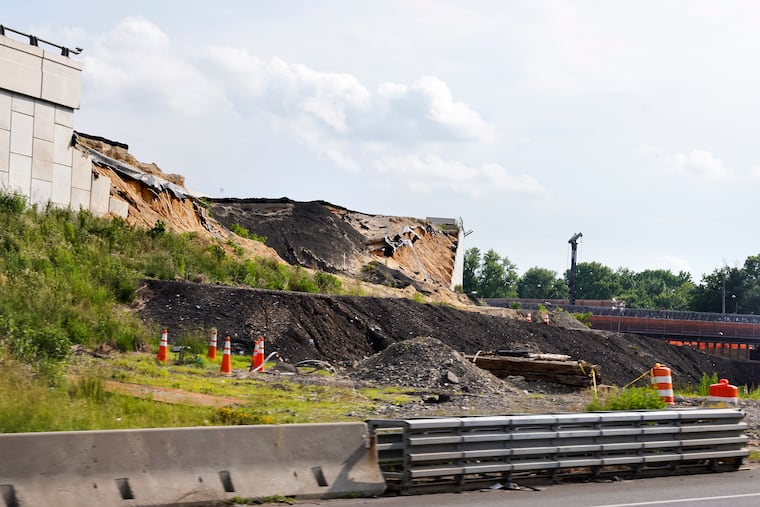N.J. hasn’t determined the repair cost of a collapsed retaining wall for I-295 or who will pay
Preliminary work on rebuilding the wall is scheduled to begin this summer.

Authorities know in great detail what caused a retaining wall to collapse in March last year on an I-295 ramp under construction in a $1.1 billion South Jersey highway project — thanks to a 10-month engineering study using tools ranging from hand shovels to probes that measure groundwater pressure in soil.
But a month after New Jersey’s Transportation Department released the findings, some questions remain unanswered, among them the cost to repair the wall and who will pay for it.
In a statement, NJDOT said that the replacement wall is being designed and that initial “site work” should begin this summer.
The project is intended to untangle the interchange where Interstates 295 and 76 and Route 42 meet in Camden County and also link Bellmawr and other local towns to the freeways. It’s a regional choke point with dangerous merges on an important route to the Shore and for Philadelphia commuters.
On large construction projects, contractors usually are required to post performance bonds so taxpayers don’t absorb repair costs if damage is caused by their mistakes, Transportation Commissioner Diane Gutierrez-Scaccetti told area residents and elected officials at a virtual town-hall session in April 2021.
The department typically pays if damage is inflicted by natural occurrences, she said.
“If it’s a contract issue or a design issue, then we will make certain that we hold them accountable, and that we’re not paying for it,” Gutierrez-Scaccetti said. She stressed at the time that it was far too early to say who is responsible.
Hardesty & Hanover LLC, the firm hired to investigate, concluded that Wall 22 in Bellmawr suffered a “complex failure” that included displacement of sandy fill soil used to build the embankment and slope underneath, as well as a faulty foundation.
Contributing factors included, the report said:
The sand and silt used to build it were not appropriate material to help support a 30-foot wall because of “poor engineering properties at high moisture contents.” The site has a high groundwater level and was chronically damp or wet, and there was heavy rainfall the day before the March 25, 2021, collapse.
A foundation of unreinforced concrete columns and a load-transfer mat made of steel mesh was not adequate to handle the weight pressing down from above or to withstand shearing when the soil gave way.
The report did not determine responsibility for the collapse, which officials said was beyond the scope of the “forensic engineering” study. NJDOT said in its statement, issued on June 15, that fault has not been determined.
The elevated roadway supported by the wall was not open to traffic, and no one was injured when the wall gave way.
It’s unclear how long it will take to build a new wall and whether that will extend the projected completion date for the already delayed megaproject. NJDOT said it is working with the contractors to coordinate the reconstruction with ongoing work to avoid delays.
Construction began in summer 2013 and initially was supposed to be done last year. The latest projected finish is 2027.